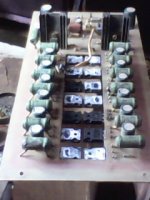does the output current of 9ma of 811 and 60ma of 810 would be sufficient to drive the IRFP240 and 9240?
what gate resistors are required to use with 810 or 811...
what gate resistors are required to use with 810 or 811...
but how much in general to be used.. I have checked the following website
Using HEXFETs in High Fidelity Audio
but it states that according to the Gate capacitance the calculated gate current is 350ma? isnt it too high? I never saw any IRF240 based amplifier to have such a high gate current for the output stages...
so if that the case one irf610 can drive may be at the max only 2 or 3 IRF240s...
what im trying to do is i would like to use a single lme49830 without a driver to drive the IRFP240 for low power amplifiers like hardly 50w-100w class AB or the reason behind it is i want to reduce the number of components in the path.
Using HEXFETs in High Fidelity Audio
but it states that according to the Gate capacitance the calculated gate current is 350ma? isnt it too high? I never saw any IRF240 based amplifier to have such a high gate current for the output stages...
so if that the case one irf610 can drive may be at the max only 2 or 3 IRF240s...
what im trying to do is i would like to use a single lme49830 without a driver to drive the IRFP240 for low power amplifiers like hardly 50w-100w class AB or the reason behind it is i want to reduce the number of components in the path.
350mA? I think that is the bias of the output transistor. Unlike BJT's, Mosfets in general have a widely varying transconductance (Gm). Gm decreases significantly as the device conducts less Id, say under a few hundred mA. Rod is saying it is important to bias these transistors a 350mA in order to lessen the distortion effects of the drop in Gm around the current crossover. (current and voltage may not crossover at the same time because of speaker reactance)
The gate does not require current like the base of a BJT but rather charge as in like charging a capacitor, and this is dependent on frequency. If you look at a complementary source follower output you see that Cgs is bootstrapped by the output. This means the only voltage change that Cgs sees is the change in Vgs that is related to the change in Id. The real internal capacitance that is the problem is Cgd, but this only comes into play at clipping because otherwise it is much smaller. 15-20mA of current in the driver stage per pair is plenty.
The gate does not require current like the base of a BJT but rather charge as in like charging a capacitor, and this is dependent on frequency. If you look at a complementary source follower output you see that Cgs is bootstrapped by the output. This means the only voltage change that Cgs sees is the change in Vgs that is related to the change in Id. The real internal capacitance that is the problem is Cgd, but this only comes into play at clipping because otherwise it is much smaller. 15-20mA of current in the driver stage per pair is plenty.
I would say it probably will work fine but if there is slew limiting or crossconduction due to slow turnoff, a driver stage could be used. You would want to drive both devices in a pair like in the app note with the Vbe (Vgs) multiplier. Vertical fets need thermal compensation as to BJTs.
yeah thermal compensation is fine we will anyway add it. I think switching to 830 is better choice if to be driven IRF and also the output current is 56ma would suffice and 830 is specific for mosfets... but 811 be used for class A well..
I would say for 1 pair of IRFP240/9240 you should use 15mA or more.
For two pair double this.
I would probably use 20-30mA per pair, if the driver can take this
For two pair double this.
I would probably use 20-30mA per pair, if the driver can take this
you need both in push pull config.240 or 9240
start with smaller one pair version and then do big amplifier as big amps needs very huge power supplies with massive trafo and big caps handling these not that easy at first go..
- Status
- Not open for further replies.
- Home
- Amplifiers
- Solid State
- directly driving the IRFP240 n 9240 using the LME49810 or 811
